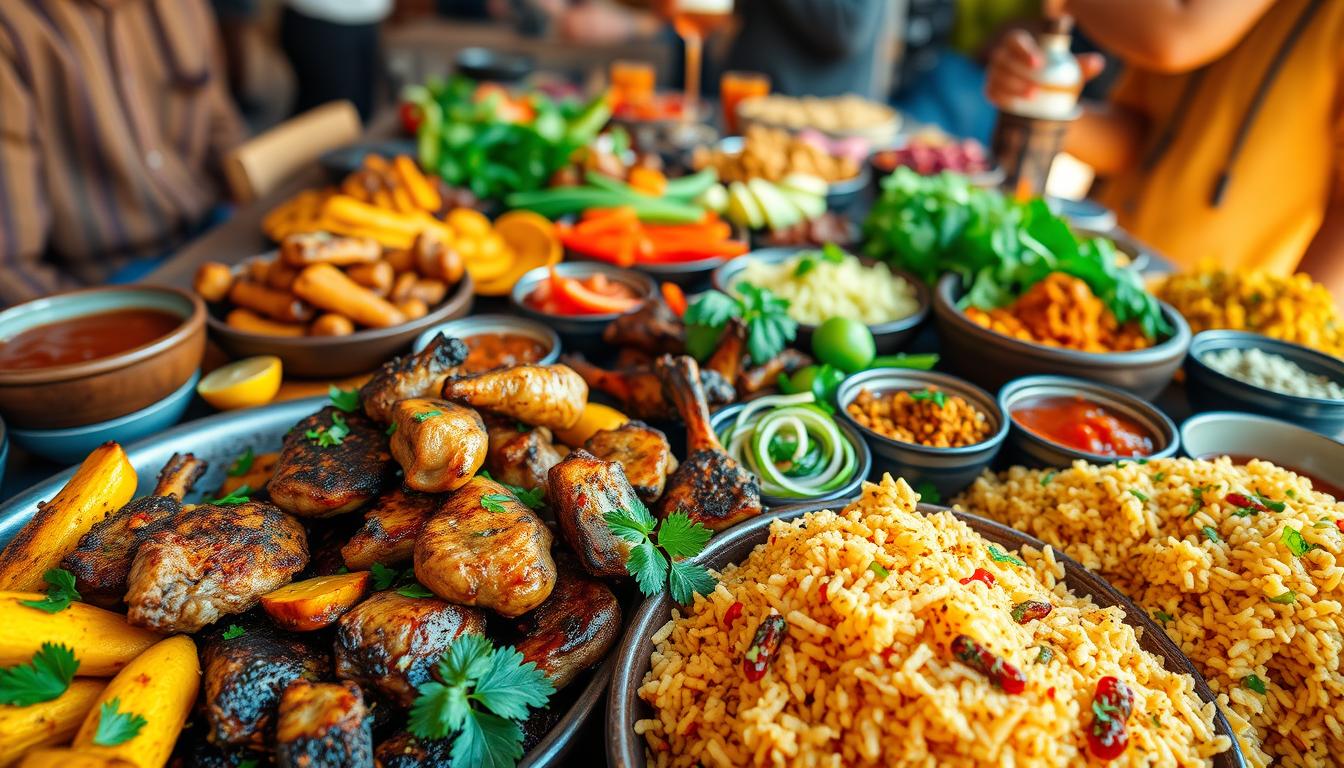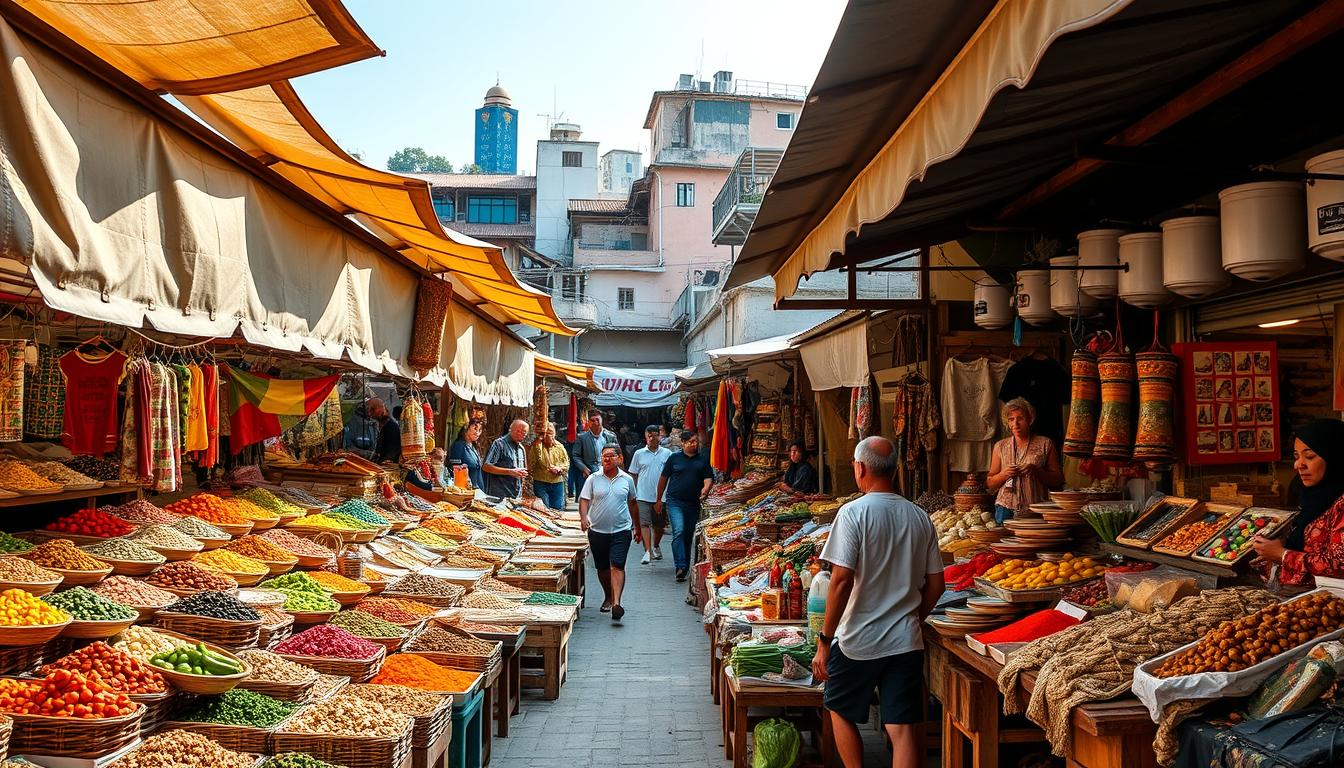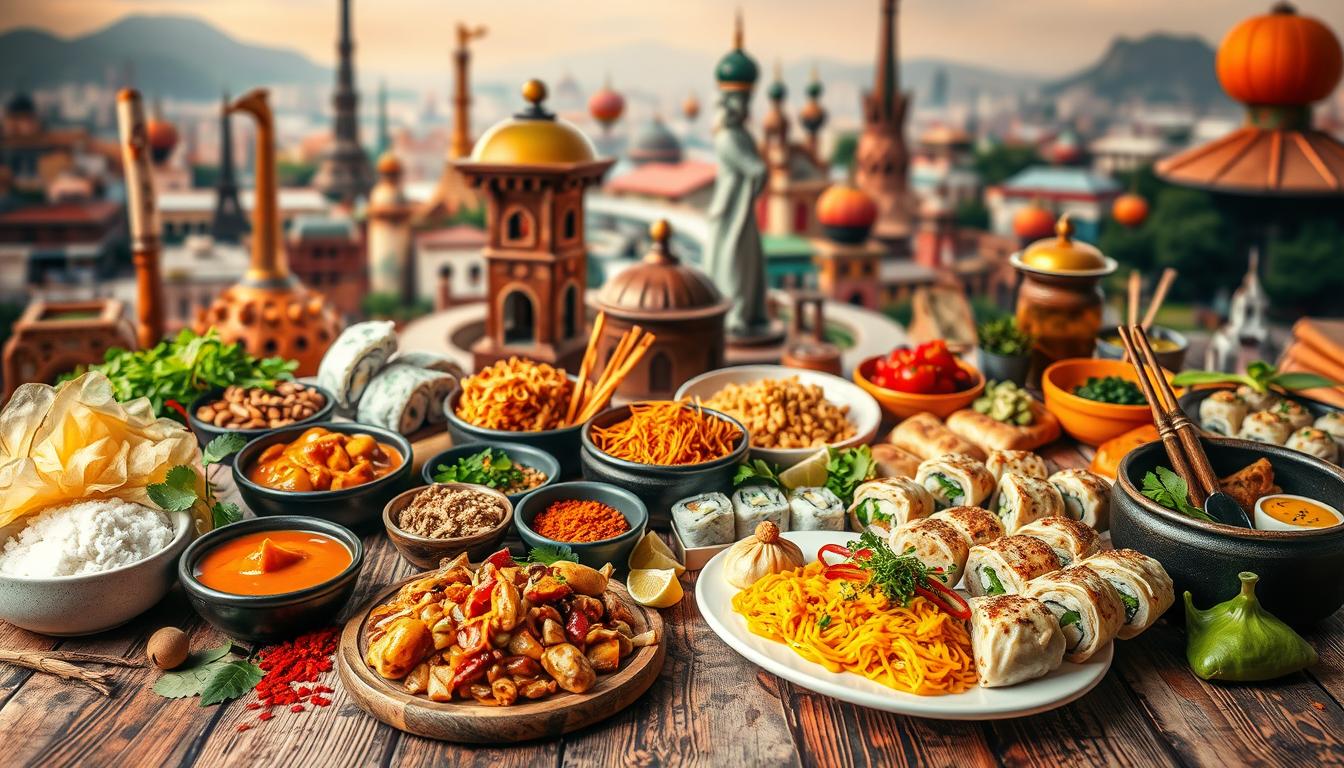Embark on a culinary journey around the world and discover the rich diversity of cultural foods that await you. From the spices of Asia to the comfort dishes of Europe, every region offers a unique taste of its heritage.
Exploring traditional cuisine is not just about food; it’s about experiencing the history and culture behind each dish. As you travel through different cultures, you’ll encounter a wide array of global flavors that will tantalize your taste buds and broaden your culinary horizons.
Key Takeaways
- Discover the unique flavors of different cultures
- Explore traditional cuisine from around the world
- Experience the history and culture behind each dish
- Broaden your culinary horizons with global flavors
- Try new and exciting cultural foods today
The Global Significance of Cultural Foods
Food is a universal language that bridges cultural divides and fosters understanding. Cultural foods are more than just something we eat; they are a reflection of our identity, history, and traditions.
The Connection Between Food and Cultural Identity
Food plays a crucial role in shaping cultural identity. Traditional dishes often symbolize community and heritage, passed down through generations. For instance, the preparation and sharing of meals during holidays and celebrations reinforce cultural bonds.
How Traditional Recipes Preserve Heritage
Traditional recipes are a vital link to our cultural heritage. They preserve historical cooking methods and ingredient choices, telling stories of migration, adaptation, and cultural exchange. Some key aspects include:
- Use of local and seasonal ingredients
- Techniques passed down through generations
- Dishes that commemorate historical events or figures
The Joy of Culinary Exploration
Exploring cultural foods brings joy through the discovery of new flavors and cooking techniques. It encourages culinary creativity and appreciation for diverse traditions. Some benefits include:
- Enhanced understanding of different cultures
- Appreciation for the art of traditional cooking
- Opportunities to try new ingredients and recipes
Cultural foods enrich our lives, connecting us to our heritage and to each other. By embracing and celebrating these culinary traditions, we foster a more inclusive and appreciative global community.
Asian Cultural Foods That Will Tantalize Your Taste Buds
Asia, a continent known for its diverse culinary landscape, offers a myriad of flavors that tantalize taste buds worldwide. The continent’s rich cultural heritage is reflected in its cuisine, with each country offering unique dishes that have gained international recognition.
Japanese Delicacies Beyond Sushi
While sushi is a well-known Japanese dish, there’s more to Japanese cuisine than this iconic food. Japanese delicacies offer a range of flavors and textures that are sure to delight.
Okonomiyaki and Takoyaki Street Foods
Okonomiyaki, a savory pancake, and takoyaki, crispy balls filled with octopus, are popular street foods in Japan. These dishes showcase the country’s love for creative, flavorful food.
The Art of Ramen
Ramen, a noodle soup dish, has become a global phenomenon. Japanese ramen is known for its rich broth and variety of toppings, making it a comforting and satisfying meal.
Chinese Regional Specialties Worth Discovering
China’s culinary landscape is vast and varied, with different regions offering their own specialties. From the spicy dishes of Sichuan province to the delicate dim sum of Cantonese cuisine, there’s a wealth of flavors to explore.
The Vibrant Flavors of Thai Cuisine
Thai cuisine is known for its bold and aromatic flavors, combining sweet, sour, salty, and spicy notes. Dishes like tom yum soup and green curry have gained international popularity, showcasing the cuisine’s vibrant flavors.
Korean Dishes That Are Gaining Global Popularity
Korean cuisine, with its emphasis on fermented foods and spicy flavors, is gaining global recognition. Dishes like kimchi stew and bibimbap are becoming staples in international cuisine, reflecting the growing interest in Korean food.
Exploring Asian cultural foods is a journey through the continent’s diverse culinary traditions. With its rich flavors and varied dishes, Asian cuisine continues to captivate food enthusiasts worldwide.
European Culinary Treasures to Experience
Exploring European cuisine is like embarking on a flavorful journey through various cultures and traditions. European culinary heritage is rich and diverse, offering a wide range of dishes that are both comforting and sophisticated.
Italian Classics Beyond Pizza and Pasta
Italian cuisine is renowned worldwide, but there’s more to it than just pizza and pasta. Dishes like risotto alla Milanese, Osso Buco, and Pollo alla Cacciatora showcase the complexity and depth of Italian cooking. Italian cuisine varies greatly by region, with the north famous for its creamy risottos and the south for its bold, tomato-based sauces.
French Dishes That Define Gourmet Cooking
French cuisine is often considered the epitome of gourmet cooking. Classic dishes like Coq au Vin, Duck L’Orange, and Boeuf Bourguignon are staples of fine dining. French patisserie is also world-famous, with delicacies like Croissants and Macarons being favorites among dessert lovers.
Spanish Tapas Culture and Must-Try Dishes
Spanish tapas culture is a culinary experience like no other. From Patatas Bravas to Croquetas, tapas offer a variety of flavors and textures. Paella, a traditional Spanish rice dish, is also a must-try, with variations like Paella Valenciana and Paella de Marisco.
Eastern European Comfort Foods
Eastern European cuisine is known for its hearty comfort foods. Pierogi from Poland and Goulash from Hungary are just a couple of examples. Russian and Ukrainian dishes like Pelmeni and Varenyky are also popular, often filled with meat, cheese, or fruit.
Polish Pierogi and Hungarian Goulash
Polish Pierogi are dumplings typically filled with potatoes, cheese, or meat. Hungarian Goulash, a rich beef stew, is a staple of Hungarian cuisine. Both dishes are comforting and flavorful, reflecting the hearty nature of Eastern European cooking.
Russian and Ukrainian Specialties
Russian and Ukrainian cuisines share many similarities, with dishes often centered around meat, potatoes, and bread. Pelmeni, Russian dumplings, and Varenyky, Ukrainian dumplings, are both filled with a variety of ingredients, showcasing the diversity of Slavic cuisine.
| Dish | Country | Description |
|---|---|---|
| Pierogi | Poland | Dumplings filled with potatoes, cheese, or meat. |
| Goulash | Hungary | A rich beef stew. |
| Pelmeni | Russia | Dumplings filled with meat. |
Middle Eastern and Mediterranean Delights
From the aromatic spices of Lebanon to the hearty dishes of Greece, the Middle Eastern and Mediterranean cuisines are a celebration of simple, wholesome ingredients. The regions’ culinary traditions are characterized by their emphasis on fresh ingredients, herbs, and olive oil, creating a distinct flavor profile that is both vibrant and inviting.
Lebanese and Syrian Mezze Platters
Lebanese and Syrian mezze platters are a cornerstone of hospitality in these cultures, featuring a variety of small dishes that are rich in flavor and texture. Tabbouleh, a salad of bulgur, parsley, and tomatoes, is a refreshing start, while hummus and baba ganoush provide creamy dips for pita bread. These platters are not just about the food; they’re an experience, encouraging communal eating and conversation.
“The art of mezze is in the variety and the sharing.”
Turkish Culinary Traditions
Turkish cuisine is renowned for its kebabs, succulent meats grilled to perfection, often served with a side of pide, a Turkish flatbread that is crusty on the outside and soft within. Baklava, a sweet pastry made with layers of phyllo, nuts, and honey, is a classic dessert that concludes meals on a sweet note.
Kebabs, Pide, and Baklava
The combination of kebabs and pide is a staple of Turkish dining, offering a satisfying meal that is both flavorful and filling. For dessert, baklava is a must-try, with its layers of flaky pastry and sweet, sticky honey.
Greek Dishes That Celebrate Simple Ingredients
Greek cuisine is a testament to the beauty of simplicity, with dishes that highlight the freshness of the ingredients. Moussaka, a layered dish of eggplant, ground meat, and béchamel sauce, is a classic, while Greek salad, with its tomatoes, cucumbers, feta, and olives, is a refreshing and light option. Grilled octopus, drizzled with olive oil and lemon, is another delicacy that showcases the region’s seafood.
The Middle Eastern and Mediterranean regions offer a culinary journey that is as much about the food as it is about the culture and hospitality. Exploring these delights is an invitation to experience the richness of these traditions firsthand.
African Cultural Foods That Deserve More Recognition
Africa’s culinary identity is as diverse as its cultures, with various regions offering unique dishes that deserve global recognition. The continent’s rich culinary heritage is a testament to its history, cultural diversity, and the creativity of its people.
North African Tagines and Couscous Dishes
North African cuisine, particularly in Morocco, Algeria, and Tunisia, is known for its rich tagines and fluffy couscous. Tagines are slow-cooked stews made in clay pots with conical lids, allowing the flavors to meld together beautifully. Couscous, a staple made from semolina flour, is often served with vegetables, meat, and sauces.
West African Stews and Staples
West Africa is renowned for its hearty stews and staple dishes that vary from country to country. Jollof rice, a one-pot dish made with rice, tomatoes, and spices, is a favorite in Nigeria and other parts of West Africa. Ghanaian cuisine, on the other hand, boasts fufu, a dough-like staple made from boiled and pounded cassava or yams, often served with light soup.
Nigerian Jollof Rice and Ghanaian Fufu
Nigerian jollof rice is celebrated for its spicy flavor, while Ghanaian fufu is cherished for its unique texture and the communal experience of eating it. Both dishes are central to their respective cultures and are often served at social gatherings.
- Jollof rice is a symbol of Nigerian hospitality.
- Fufu is traditionally eaten with the hands, promoting communal dining.
Ethiopian Cuisine and the Art of Communal Dining
Ethiopian cuisine is distinct for its use of injera, a sourdough flatbread made from teff flour. Injera serves not only as a food item but also as a utensil, as people tear off pieces to pick up various stews and salads. This practice fosters communal dining, a significant aspect of Ethiopian culture.
African cultural foods are more than just meals; they are a bridge to understanding the continent’s diverse cultures and traditions. By exploring these cuisines, we can appreciate the rich tapestry of African heritage.
Latin American Flavors to Spice Up Your Palate
From the spicy kick of Mexican dishes to the smoky flavors of Brazilian barbecue, Latin American cuisine offers a culinary adventure like no other. The region’s diverse geography and rich cultural heritage have blended together to create a vibrant tapestry of flavors that are sure to tantalize your taste buds.

Mexican Dishes Beyond Tacos and Burritos
Mexican cuisine is more than just tacos and burritos; it’s a complex and nuanced culinary tradition that offers a wide range of delicious dishes. Some must-try Mexican dishes include:
- Mole: A rich, chocolate-based sauce served over chicken or turkey.
- Chiles Rellenos: Roasted poblano peppers stuffed with cheese, battered, and fried.
- Enchiladas: Tortillas filled with meat or cheese, rolled, and covered in a spicy tomato sauce.
Brazilian Barbecue and Street Food
Brazilian barbecue, or churrasco, is a beloved culinary tradition that involves grilling meats over an open flame. Some popular Brazilian barbecue dishes include:
- Picanha: A type of rump cap that’s considered a national dish in Brazil.
- Churrasco Skewers: Marinated meats grilled on skewers.
Peruvian Fusion Cuisine
Peruvian cuisine is a fusion of indigenous, Spanish, African, and Asian influences, creating a unique and exciting culinary experience. Some must-try Peruvian dishes include:
Ceviche and Lomo Saltado
Ceviche is a refreshing dish made with raw fish marinated in citrus juices, while Lomo Saltado is a stir-fry dish that combines beef, vegetables, and French fries, showcasing the Chinese influence on Peruvian cuisine.
Caribbean Tastes and Influences
The Caribbean region is known for its bold flavors and spices, with dishes often featuring ingredients like coconut, allspice, and scotch bonnet peppers. Some popular Caribbean dishes include:
- Jerk Chicken: Marinated chicken grilled over an open flame.
- Conch Fritters: Crispy fried balls filled with conch meat.
Understanding Cultural Foods and Their Historical Context
The history behind cultural foods is deeply intertwined with the stories of migration and cultural exchange. As people move from one place to another, they bring with them their culinary traditions, adapting to new environments and incorporating local ingredients. This process enriches the culinary landscape, creating a diverse and vibrant food culture.
How Migration Shapes Culinary Traditions
Migration plays a crucial role in shaping culinary traditions. As people migrate, they carry their recipes and cooking techniques with them, often adapting these to the ingredients available in their new location. For instance, the fusion of Mexican and American cuisines has given rise to Tex-Mex, a unique culinary tradition that reflects the cultural exchange between the two countries.
Fusion Cuisines and Cultural Exchange
Fusion cuisines are a direct result of cultural exchange, where different culinary traditions come together to create something new and exciting. This blending of cuisines not only reflects the diversity of cultures but also promotes cross-cultural understanding and appreciation. As Anthony Bourdain once said, “Your body is not a temple, it’s an amusement park. Enjoy the ride.” This quote encapsulates the joy of exploring different cuisines and the cultural exchange that comes with it.
Celebrating Food as Cultural Heritage
Celebrating food as cultural heritage is essential for preserving history and promoting cultural unity. By understanding and appreciating the cultural significance of food, we can foster a deeper connection with the communities that have shaped these culinary traditions. As
“Food is everything we are. It’s an extension of nationalist feeling, ethnic feeling, your personal history, your province, your region, your tribe, your grandma. It’s inseparable from those from the get-go.”
This highlights the importance of food in understanding cultural identity.
Where to Find Authentic Cultural Foods in America
From vibrant cultural food markets to authentic eateries, America offers a rich culinary landscape that celebrates global cuisines. For food enthusiasts, exploring these options can be a delightful adventure.
Cultural Food Markets and Specialty Stores
Cultural food markets and specialty stores are treasure troves for those seeking authentic ingredients and products from around the world. These markets not only offer a taste of global cuisines but also provide an opportunity to explore different cultures through their food.
Top International Markets in Major US Cities
Major US cities are home to a variety of international markets. For instance, in New York, the Queens International Night Market showcases a diverse range of cuisines, from Asian fusion to Latin American street food. Similarly, in Los Angeles, Grand Central Market offers a mix of traditional and modern eateries serving authentic dishes.

Restaurants Offering Authentic Experiences
Restaurants specializing in authentic cuisine from various cultures provide a genuine dining experience. Whether it’s a Japanese izakaya in San Francisco or an Indian curry house in Chicago, these eateries bring the flavors and traditions of their respective cultures to the forefront.
Food Festivals Celebrating Global Cuisines
Food festivals are another excellent way to experience authentic cultural foods. Events like the New Orleans Jazz & Heritage Festival and the Smithsonian Folklife Festival in Washington, D.C., celebrate global cuisines with a diverse range of food vendors.
Online Resources for Imported Ingredients
For those who prefer cooking at home, online resources provide access to imported ingredients and specialty products. Websites like Amazon and World Market offer a wide selection of international goods, making it easier to recreate authentic dishes in your own kitchen.
Conclusion: Embracing Diversity Through Culinary Adventures
Exploring cultural foods offers a unique lens through which to appreciate cultural diversity. By embracing culinary adventures, we enrich our palates and foster a deeper understanding of the cultures behind the cuisine. Global flavors have the power to unite people across the globe, celebrating the rich tapestry of culinary traditions.
Whether through cooking at home, dining at international restaurants, or attending food festivals, the world of cultural foods invites us to embark on a delicious journey of discovery. As we savor the flavors of different cultures, we not only enjoy the culinary delights but also gain insight into the history, traditions, and values of the communities that created them.
By continuing to explore and appreciate global flavors, we promote cultural diversity and understanding, one meal at a time. So, let’s continue our culinary adventures, embracing the diversity that makes our culinary world so rich and vibrant.
FAQ
What are cultural foods?
Cultural foods refer to the traditional and characteristic dishes of a particular culture or region, often reflecting the history, values, and identity of the community.
How do cultural foods preserve heritage?
Cultural foods preserve heritage by passing down traditional recipes and cooking techniques from one generation to the next, maintaining cultural identity and community bonds.
What is the significance of food in cultural identity?
Food plays a significant role in cultural identity as it reflects the history, values, and traditions of a community, often serving as a symbol of cultural heritage and unity.
Where can I find authentic cultural foods in the US?
Authentic cultural foods can be found in international markets, specialty stores, and restaurants that specialize in traditional cuisine from around the world, as well as at food festivals celebrating global cuisines.
How do migration and cultural exchange influence culinary traditions?
Migration and cultural exchange influence culinary traditions by introducing new ingredients, cooking techniques, and dishes, often resulting in the creation of fusion cuisines that blend different cultural flavors.
What are some must-try cultural foods from different regions?
Some must-try cultural foods include Japanese ramen, Chinese regional specialties, Thai street food, Korean BBQ, Italian osso buco, French bouillabaisse, Spanish tapas, and African tagines, among many others.
How can I learn more about cultural foods and their historical context?
You can learn more about cultural foods and their historical context by exploring cookbooks, food documentaries, and online resources that highlight the cultural significance and history behind different dishes.
What is the role of food festivals in promoting cultural cuisine?
Food festivals play a significant role in promoting cultural cuisine by celebrating different cultures and cuisines, providing a platform for cultural exchange, and offering a taste of global flavors.
Can I find cultural foods online?
Yes, you can find cultural foods online through specialty stores, online markets, and recipe platforms that offer a wide range of international ingredients and recipes.




Pingback: Explore the Flavors of Costa Rican Culture and Food - addlevelup
Pingback: American Food Culture: A Flavorful Journey - addlevelup